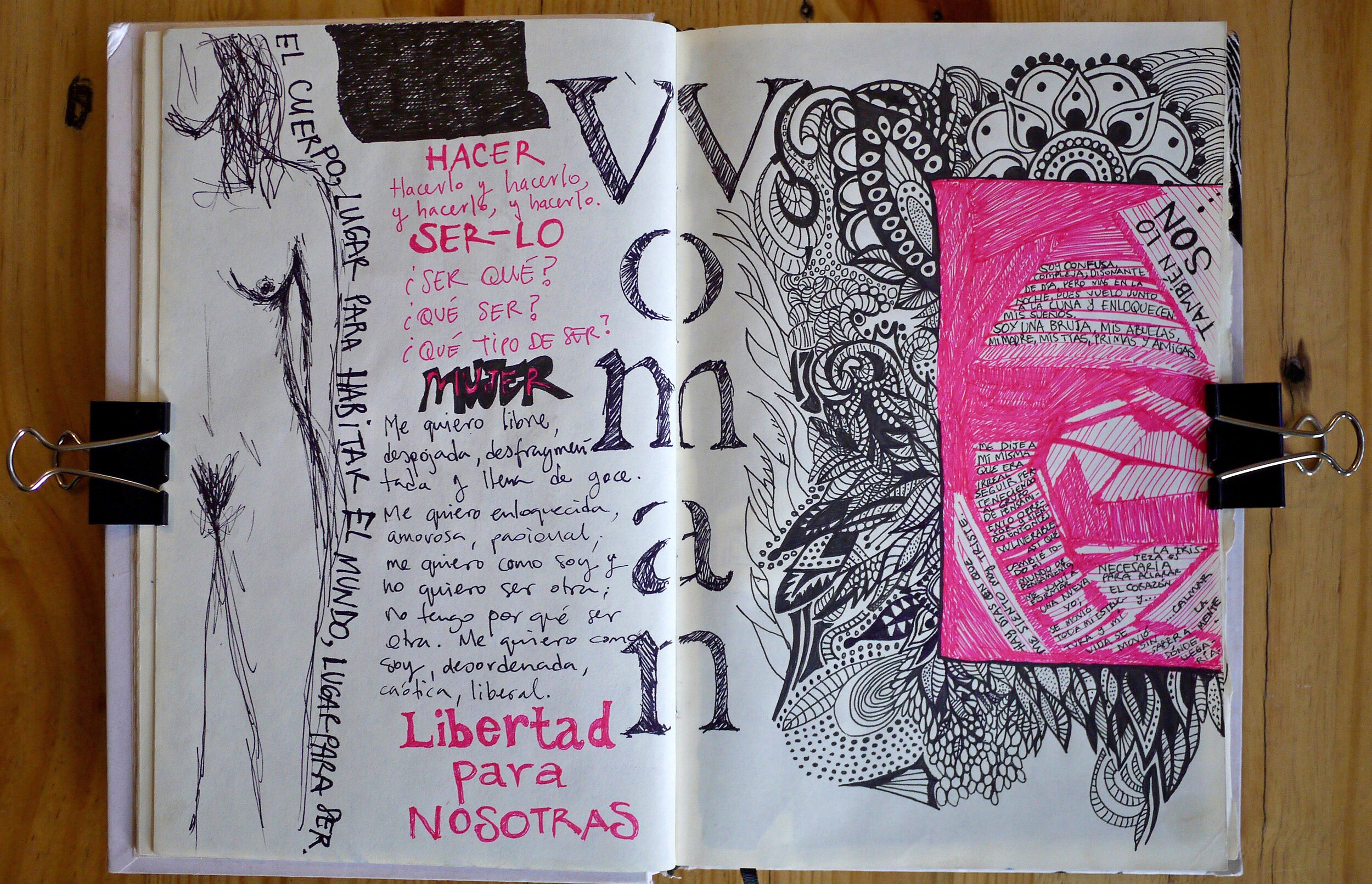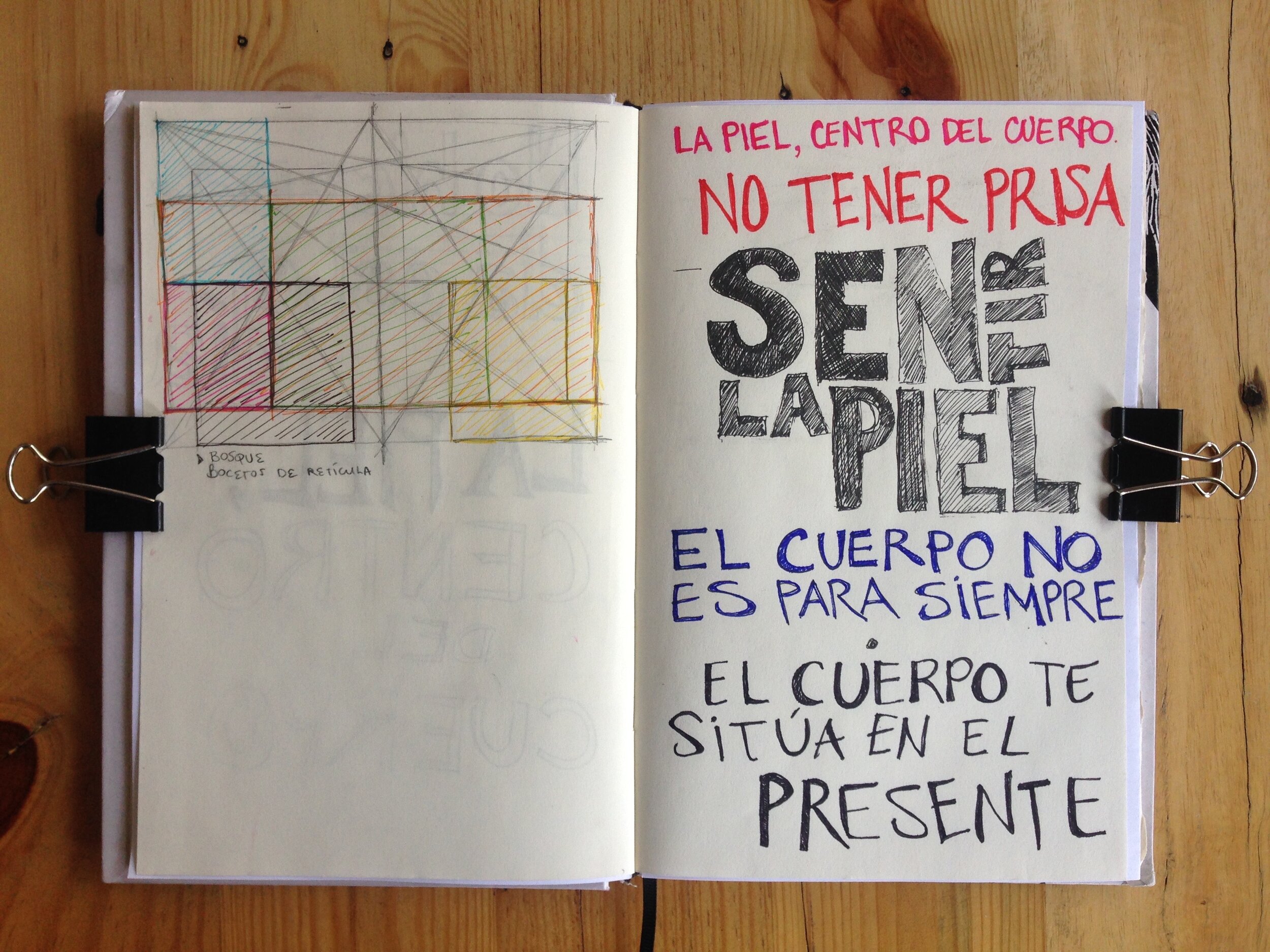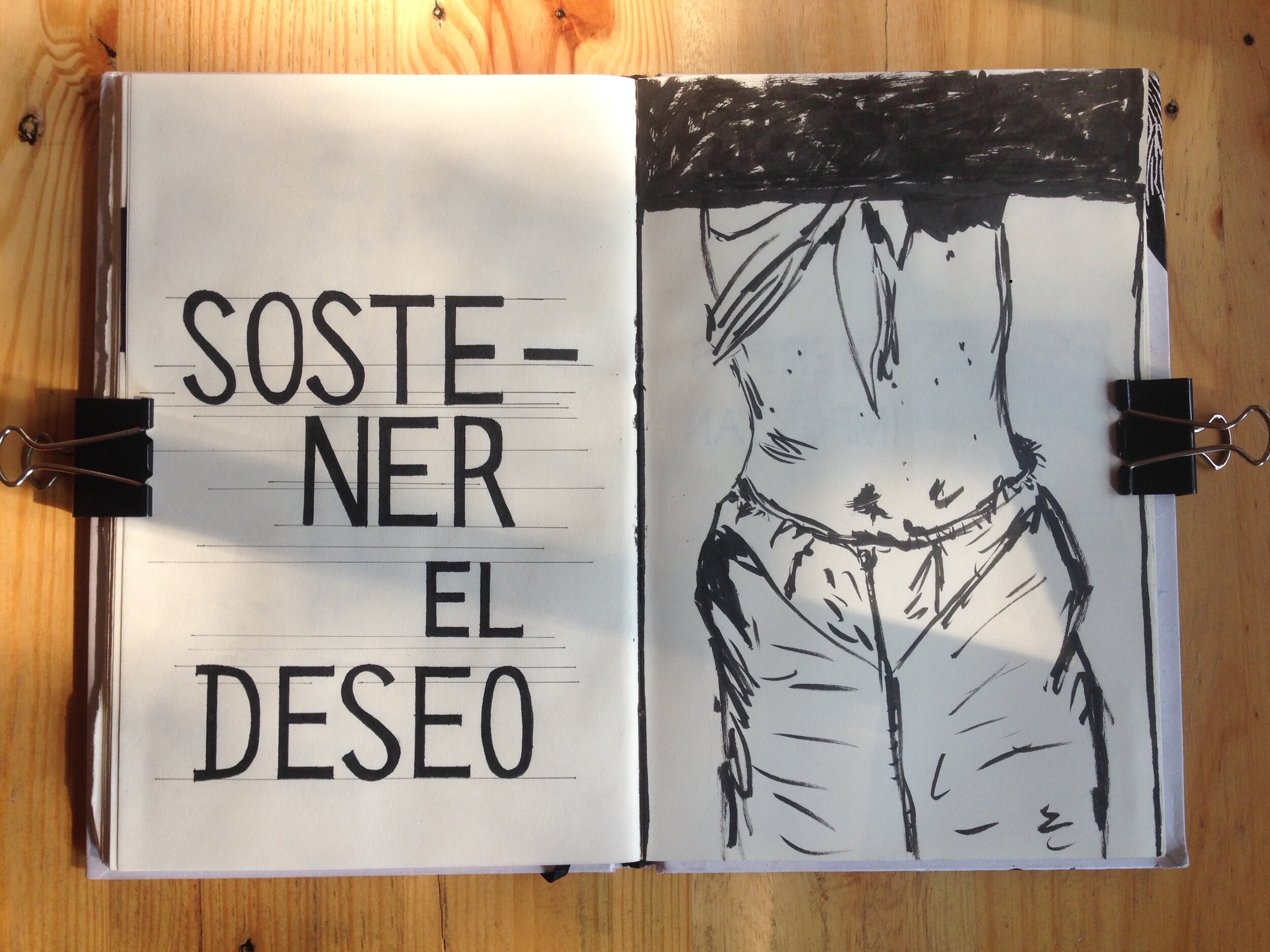Cuerpo habitado. Sobre el cuerpo y sus escrituras, de Nayeli Benhumea
Inhabited body. On the body and its writings, by Nayeli Benhumea
Me interesa re-pensar mi cuerpo como un territorio donde convergen un sinfín denociones que se tensionan y chocan entre sí, ideologías que no precisamente tienenque ver con la corporalidad que soy, sino con las pulsiones que emergen de mí y no delos condicionamientos arraigados desde la cultura, esos espacios de lo social, lopolítico, sexual e individual, que en todo momento encarcelan al cuerpo.Es desde mi cuerpo que hago visible mi relación con el mundo, mi sentir, mi estar, misideas y posturas políticas, críticas, mis malestares con el mundo, mis cuestionamientossobre el yo, el nosotros, lo colectivo, los roles de género, las relaciones personales, lascondiciones sobre lo amoroso y lo sexual, el deseo y el goce, el rechazo de nuestroscuerpos y la negación constante de estos.Mi trabajo se ha basado en la observación de mí misma como alguien ajena que semira reconociéndose, transformando todo aquello que no forma parte propiamente demi naturaleza expandida y cíclica.Del cuerpo lo que quiero son sus transformaciones liberadoras de los deseos, suspasiones, sus límites, sus miedos, sus dolores; devolverle a éste su pensamiento y asíhabitar este plano mágico y terrenal.Recurro a la escritura como un lugar de exploración para el cuerpo en tanto sudesaprendizaje y con éste, la reconstrucción de la que soy. A través de la observación yla relectura de mis nociones, aprendo la que soy y desaprendo la que quiero ser, esdecir, “la que quiero ser” no es la que en verdad soy, por ejemplo, cuando quiero quemi cuerpo sea y se comporte a partir de una construcción de lo femenino.Es desde el auto reconocimiento y la intuición que me acerco al feminismo para luegoformular un pensamiento filosófico –parafraseando a Graciela Hierro cuando hablasobre el método feminista que sigue los pasos iniciados con una crisis existencial y eldespertar de la conciencia.Esta muestra conjuga algunos trabajos que a lo largo de mi producción he realizadoalrededor de esta problemática. Es a partir de mi propia experiencia (como ex-peira –después de la experimentación con lo real) y mi propio cuerpo, que giran estasreflexiones para incitar a la construcción de un pensamiento feminista. “El métodofeminista se nutre de la sabiduría que encierran los escritos consignados en el discursono oficial de lo femenino, como memorias, diarios, biografías y cuadernos de contar lavida; además de cartas, novelas, cuentos y poesía, todos los escritos por mujeres parailustrar su experiencia femenina”.1 Mi trabajo se instala en este método sobre lopersonal como sabiduría alrededor de lo femenino. 1.Hierro, G., La ética del placer, Editorial Diversa, UNAM, México, 2014.
Propongo que antes de empezar este recorrido, hagamos juntas un ejercicio:1. Toma una hoja y una pluma, colores, lápices, algo para dibujar y escribir.2. Dibuja tu silueta de memoria. Imagínate de pie, como si te vieras a la distancia ytrázate.3. Señala en el dibujo los lugares que estés sintiendo ahora mismo sobre tu cuerpofísico, pueden ser dolores, placeres, miedos, ideas, pensamientos, pueden responder alas preguntas ¿cómo es mi cuerpo? ¿cómo lo veo?, u otras que tu te hagas. Escríbelasa manera de mapa sobre tu propio dibujo.4. Ponte de pie, pon música que te guste y baila, suelta todo lo que acabas de escribir.5. Si quieres, manda tu dibujo a naye.benhumea@gmail.com, los dibujos los subiré a miblog personal: www.nayelibenhumea.wordpress.comLes dejo una rola que me gusta para que dibujen:https://www.youtube.com/watch?v=K3YVlm3_tt8 ¿acaso no pensamos con el cuerpo? Desertar al/el cuerpo* from Nayeli Benhumea on Vimeo.El desierto como lugar simbólico para la soledad y el reencuentro conmigo, con todas.Desertar de lo preconcebido y establecido socialmente como "lo femenino" o lo quetengo que ser y hacer para ser mujer.Allí está el desierto, que no es, como los humanos sedentarios creen, el abandonoabsoluto al vacío, sino el lugar habitado por las multiplicidades intensivas, paraje demanadas, que los humanos no se atreven ni siquiera a ver (Manada de lobxs). El cuerpo es territorio,exploración tipográfica, sexual y textual. La escritura en sí misma, es la construcción desde y de la corporalidad.Capaz de ser. La escritura está sucediendo.En la escritura, el cuerpo es.Lugar de encuentro y coincidencia.El cuerpo del texto, el cuerpo de la escritura.El ejercicio de la escritura en todas sus formas. El primer acercamiento que tuve con el feminismo fue de mi madre. De niña laescuchaba decir que era feminista porque apoyaba la lucha de las mujeres que sonviolentadas por sus parejas, o las mujeres que se quedan solas con hijos qué cuidar, olas mujeres que eran agredidas en sus trabajos, acosadas, violadas, etc. Comencé aentender por ella en tanto feminista, era una mujer que podía hacerse cargo de símisma sin necesitar de un hombre que la cuide, una mujer que defendía la libertad de símisma frente a los demás y una manera de exigir al hombre (mi hermano en éste caso),igualdad y compromiso para con nosotras.
I am interested in re-thinking my body as a territory where an endless number of notions converge that tension and collide with each other, ideologies that do not have to do precisely with the corporality that I am, but with the drives that emerge from me and not from the deep-rooted conditioning from the culture, those spaces of the social, the political, the sexual and the individual, which imprison the body at all times. It is from my body that I make visible my relationship with the world, my feeling, my being, misideas and political positions, criticism, my discomforts With the world, my questions about the self, the us, the collective, gender roles, personal relationships, the conditions about love and sexuality, desire and enjoyment, the rejection of our bodies and the constant denial of these. This work has been based on the observation of myself as someone else who sees himself recognizing himself, transforming everything that is not properly part of my expanded and cyclical nature. body what I want are its liberating transformations of desires, its passions, its limits, its fears, its pains; give it back its thought and thus inhabit this magical and earthly plane. I resort to writing as a place of exploration for the body as long as its unlearning and with it, the reconstruction of which I am. Through observation and rereading my notions, I learn who I am and unlearn what I want to be, that is, "what I want to be" is not what I really am, for example, when I want my body to be and behave. starting from a construction of the feminine. It is from self-recognition and intuition that I approach feminism to then formulate a philosophical thought - paraphrasing Graciela Hierro when you speak about the feminist method that follows the steps initiated with an existential crisis and the awakening of consciousness This sample combines some works that throughout my production I have done around this problem. It is from my own experience (as ex-peira - after experimentation with the real) and my own body, that these reflections turn to incite the construction of feminist thought. “The feminist method is nourished by the wisdom contained in the writings recorded in the official discourse of the feminine, such as memoirs, diaries, biographies and notebooks to tell life; as well as letters, novels, stories and poetry, all written by women to illustrate their feminine experience. ”1 My work is installed in this method on the personal as wisdom around the feminine. 1. Iron, G., The ethics of pleasure, Editorial Diversa, UNAM, Mexico, 2014.
I suggest that before starting this tour, we do an exercise together: 1. Take a sheet and a pen, colors, pencils, something to draw and write. 2. Draw your silhouette from memory. Imagine yourself standing, as if you were looking into the distance and traced. 3. Point out in the drawing the places that you are feeling right now about your physical body, they can be pains, pleasures, fears, ideas, thoughts, they can answer the questions what is my body like? How do I see it ?, or others that you ask yourself. Write them as a map on your own drawing. 4. Stand up, put on music you like and dance, drop everything you just wrote. If you want, send your drawing to naye.benhumea@gmail.com, the drawings will be uploaded to my personal blog: www.nayelibenhumea.wordpress.com I leave you a track that I like to draw: https: //www.youtube.com/ watch? v = K3YVlm3_tt8 don't we think with the body? Desert the body * from Nayeli Benhumea on Vimeo. The desert as a symbolic place for solitude and reunion with myself, with all. Desert from the preconceived and socially established as "feminine" or what I have to be and do to be a woman There is the desert, which is not, as sedentary humans believe, absolute abandonment to emptiness, but the place inhabited by the intensive multiplicities, places demanded, that humans do not even dare to see (Herd of lobxs). The body is territory, typographic, sexual and textual exploration. The writing in itself, is the construction from and of the corporality. Capable of being. Writing is happening. In writing, the body is. A place of encounter and coincidence. The body of the text, the body of writing. The exercise of writing in all its forms. The first approach I had to feminism was from my mother. As a child, I heard her say that she was a feminist because she supported the struggle of women who are violated by their partners, or women who are left alone with children to take care of, or women who were assaulted in their jobs, harassed, raped, etc. I started to understand her as a feminist, she was a woman who could take care of herself without needing a man to take care of her, a woman who defended the freedom of herself from others and a way of demanding man (my brother in this case), equality and commitment to us.
El cuerpo se desnuda, se libera, se expone, se cuestiona, se ejerce.
The body is stripped, released, exposed, questioned, exercised.
¿Pensamos con el cuerpo?¿pensamos con el cuero?¿pensamos con la cue? Radio para una misma, Capitulo 2 de Nayeli Benhumea en #SoundCloudhttps://soundcloud.com/nayelibenhumea/20160622-130509a La escritura descorporaliza en tanto fragmenta al cuerpo; al fragmentarsus partes se descorporaliza la noción de un cuerpo estructurado,cerrado, invadido, oculto, doloso, violentado, controlado; se adquiere unaexperimentación sobre la posibilidad de transformar el cuerpo desdeestas estructuras simbólicas que repercuten en el sentir físico yemocional; fragmentarlo en sus distintas partes y volver a unir algunas apartir de lo que se re-construye. El cuerpo está en constante cambio,lugar donde sucede la descorporalización, pues la noción que se tiene deéste, se amplía, se modifica, y por tanto, no se piensa más como ¨cuerpo¨.El cuerpo es tiempo puro.22 Gustavo Varela, Fenomenología de la vida cotidiana “somos un cuerpo y ese cuerpo es tiempo puro”. Consultado el 28 de septiembrede 2017 en: marencoche.wordpress.com El cuerpo, como si hablara de un otro. Es mi cuerpo el que siente y descubre en suinfinitud.Mí cuerpo, el cuerpo, cuerpo, mejor cuerpa.Mí cuerpa entera se revoluciona cada segundo, al caminar, al respirar, al contacto conotrx.
¿Cuál es el cuerpo de la escritura? ¿Cuál es la escritura del cuerpo? ¿Cómo escribimos un cuerpo? ¿Cómo corporalizamos a la escritura?
Do we think with the body? Do we think with the leather? Do we think with the cue? Radio for the same, Chapter 2 of Nayeli Benhumea in #SoundCloudhttps: //soundcloud.com/nayelibenhumea/20160622-130509a The writing disembodies as it fragments the body; By fragmenting its parts, the notion of a structured, closed, invaded, hidden, malicious, violent, controlled body is disembodied; an experience is acquired on the possibility of transforming the body from these symbolic structures that affect physical and emotional feeling; fragment it into its different parts and rejoin some of what is re-built. The body is constantly changing, the place where disembodiment occurs, since the notion that one has of this, is expanded, modified, and therefore, is no longer thought of as "body". The body is pure time.22 Gustavo Varela, Phenomenology of everyday life "we are a body and that body is pure time". Consulted on September 28, 2017 at: marencoche.wordpress.com The body, as if speaking of another. It is my body that feels and discovers in its infinity. My body, the body, body, better body. My entire body is revolutionized every second, when walking, breathing, contact with trix.
What is the body of the writing? What is the body writing? How do we write a body? How do we corporalize writing?
Todas las imágenes son parte del proyecto Escrituras del cuerpo, que consiste en la realización de una bitácora o libro de artista. Trabajo en proceso, para ver más: https://escriturasobrecuerpo.tumblr.com/ Nayeli Benhumea SaltoNací en Ciudad de México, soy pasante de la Maestría en Artes Visuales, Facultad deArtes y Diseño, UNAM; Licenciada en Diseño de la Comunicación Gráfica porUniversidad Autónoma Metropolitana, Azcapotzalco; hice la Especialidad en CreaciónDancística en el Centro de Investigación Coreográfica del INBA. Soy coautora, junto conHayde Lachino del libro Videodanza. De la escena a la pantalla.Mi trabajo se ha mostrado en diferentes festivales internacionales de Marsella, Chile,Brasil, Buenos Aires, Córdoba Argentina, La Habana Cuba, Guatemala, Ecuador,Uruguay, Costa Rica y México.Soy profesora de Videoarte y de Investigación de Proyectos Artísticos en la Facultad deArtes, Universidad Autónoma del Estado de México; colaboro como diseñadora en Átimoy como diseñadora editorial para el Departamento de Evaluación en el Tiempo, CyAD,UAM Azcapotzalco; investigo, escribo, dibujo y bailo. Pueden ver más de mi trabajo en:https://nayelibenhumea.wordpress.com/


















